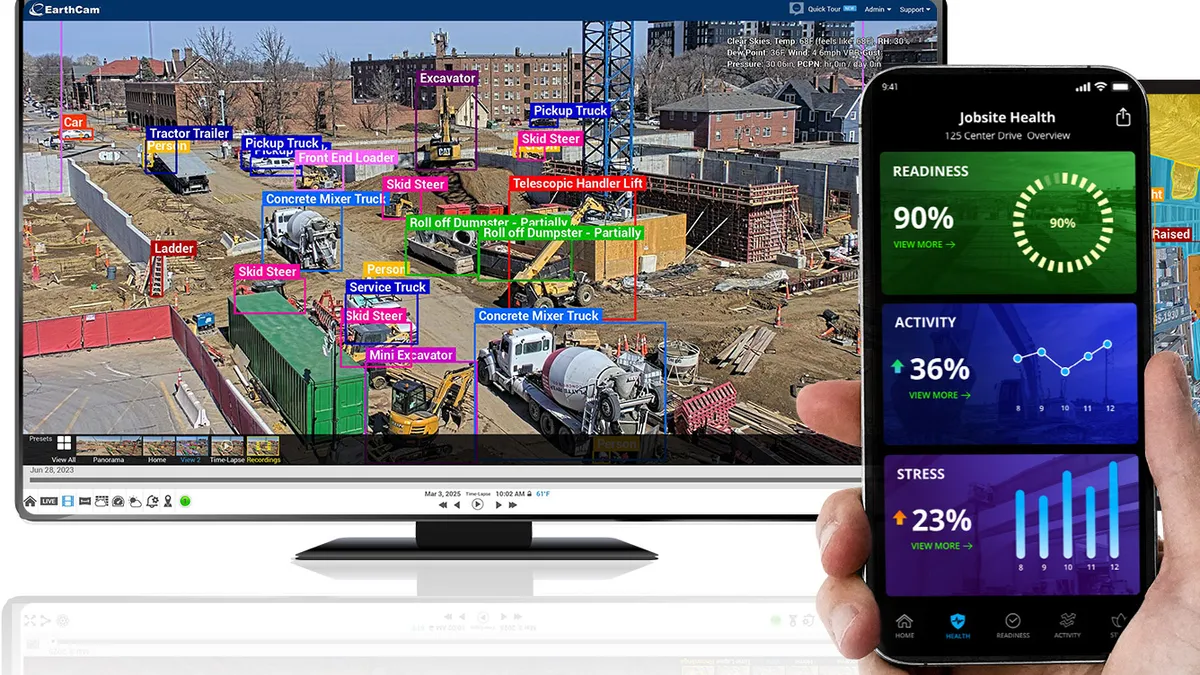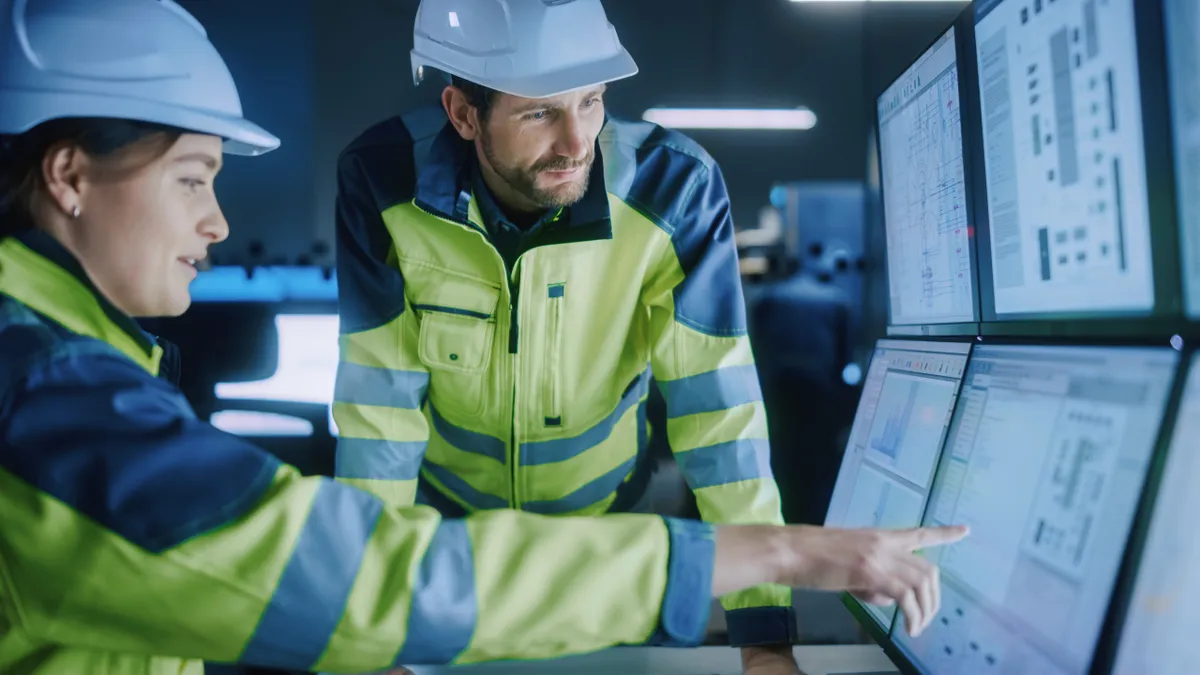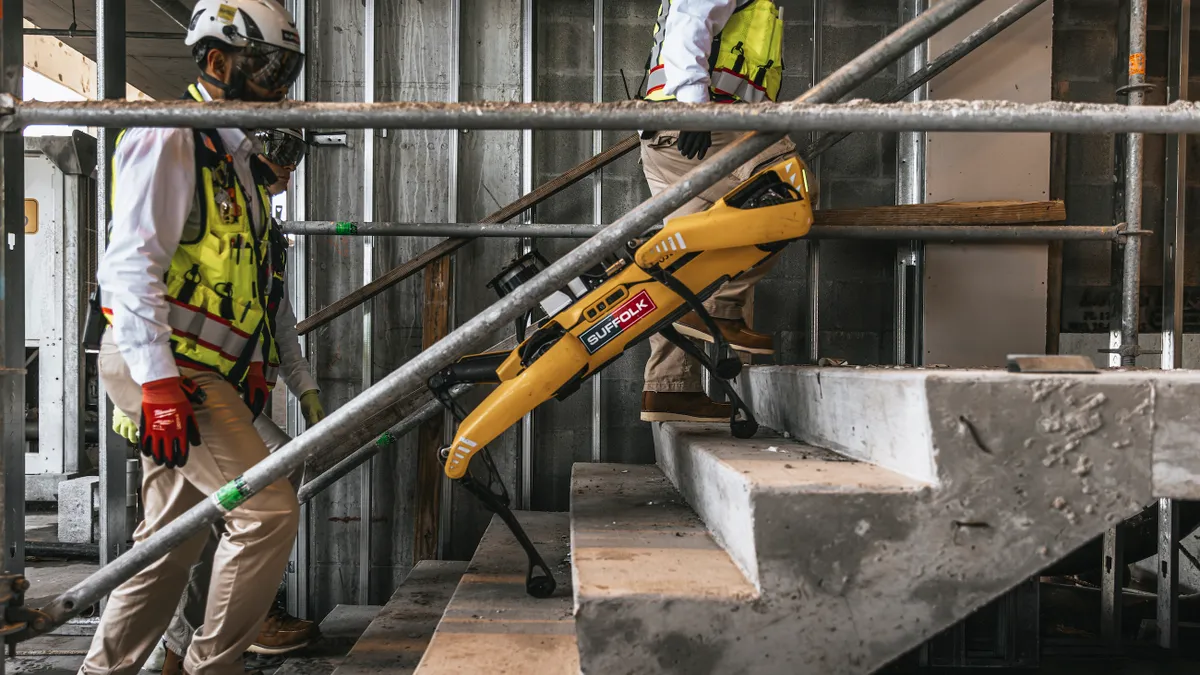With total attendance topping out at 128,000 and near endless lineups of parked heavy equipment across four behemoth lots and five conference halls in Las Vegas, ConExpo-Con/Agg 2017 lived up to its reputation as one of the world’s largest gatherings of contractor professionals and the equipment that powers global heavy construction.
A first to ConExpo this year, the 70,000-square foot Tech Experience highlighted the latest in job site, workforce, manufacturing and infrastructure technologies, but there — as elsewhere across the 2.5 million square feet of exhibit space — it was the machines that were on full display. Here’s a look at the hottest equipment software, technology and solutions at ConExpo 2017:
Drones
While surprisingly not crowding the airspace above ConExpo, drones and drone-related technology integrations were big news at the trade show. UAV experts told Construction Dive that the large public crowds and maze of erected crane-booms were a non-starter for an FAA waiver to fly at the show, restricting drone flights to a couple of small, contained flight cages at the Tech Experience campus.
Nonetheless, drone technology was featured at most major equipment vendor booths, including demonstration labs by Caterpillar, John Deere, and Komatsu, among others. Most solutions centered on site reality capture via photogrammetry for volumetric calculations of aggregate materials in movement.
Komatsu, for one, has partnered with San Francisco–based Skycatch for exporting drone data into 2-D orthomosaics and algorithmically modified 3-D point clouds, while Lausanne, Switzerland–based Pix4D has integrated its drone reality capture system with crane-mounted cameras, allowing for additional photography from cranes to be incorporated into point clouds and photo mosaics.
"Drones in a vacuum aren’t all that slick and can’t do much. It’s only in the increased integration with machine telematics and other job site systems and use-case technologies where we’ll see a surge in user value," said Dick Zhang, founder and CEO of Pittsburgh–based Identified Technologies, which introduced at ConExpo its Truck IQ platform, a sensor and software package to measure and combine vehicle load and cycle times with aerial drone data to boost earth-moving efficiency.
Telematics
Speaking of boosting equipment efficiency, major OEMs and third-party telematics platform providers leaned heavily on the benefits of wired machines and the IoT-connected job site at ConExpo. With the Association of Equipment Manufacturers standardizing telematics data protocols, most providers have been quick to tout "mixed fleet" capabilities to read and present operational, mechanical and run-time/idle data on equipment regardless of make or model.
John Deere, for example, has partnered with Houston–based HCSS to offer a cloud-based, web interface for tracking telematics data from Deere, Caterpillar, Komatsu and Volvo while also offering after-market GPS devices for tracking older equipment.
Related story: Machinery madness: The coolest exhibits at ConExpo 2017
A primary focus of telematics providers has been to reduce data overload on users who recognize the value of machine tracking but are overwhelmed with how to optimize business decisions using the data. The result has been the creation of simple-to-use performance dashboards on top of machine learning that aim to offer more predictive analytics.
"There’s all of this data coming at the user and they don’t know what to do with it, so we’re focused on a critical view of what are the things you care about and how can our learning algorithms better figure out what the end user is actually interested in," said Geet Chopra, senior product manager, business intelligence for Glenview, IL–based Teletrac Navman. "Display just that data and filter out the noise — that’s where the industry is headed and that’s where there is value for the customer."
Additive manufacturing
In conjunction with the grand opening of the ConExpo Tech Experience, Project AME — a collaboration between the Association of Equipment Manufacturers, Georgia Tech, the National Fluid Power Association, Oak Ridge National Laboratory and the University of Minnesota — unveiled its fully operational 3-D printed excavator. Although mechanicals and electrical systems were not 3-D printed, the excavator was constructed from cab, boom, and heat exchanger components all created using different additive manufacturing technologies.
At 7-feet-long and 400 pounds gross weight, the stick boom was created with a Wolf Pack metal 3-D printer in five days, while the 13-pound heat exchanger was created with a Concept Laser X-Line 1000 powder-bed printer The cab itself was printed with a room-sized Big Area Additive Manufacturing System, which built the 3-D carbon fiber and reinforced ABS plastic cab in only five hours.
Assembled at Oak Ridge National Laboratory, the excavator was a proof of concept project that team leaders said during the unveiling would lead to larger, faster and more scalable 3-D printing capabilities in construction.
Self-driving vehicles and electric drive
When it comes to powered steering in construction, diesel fuel and human operators still rule the day. Even with thousands of pieces of heavy equipment on display at ConExpo, both autonomous vehicle technology and fully electric power trains were largely absent from the trade show floor, with some notable exceptions.
Proving that cool things can come in small packages, the Track-O MINIDOZER from Shawinigan, Canada–based Movex Innovation features an all-electric power drive with remote control operability up to 300 feet. The robotic dozer has a low, 22.5-inch height profile for operation under conveyer belts and MEP systems. According to Movex sales and marketing manager Jean-Yves Bacle, full autonomy is next.
"We think autonomy in construction is just three to five years away, compared to another 20 or so years for over-the-road vehicles, simply because in construction you are dealing with a more controlled environment," Bacle said. "Migrating from diesel to electric is a big deal."
Fully electric, fully autonomous and also completely 3-D printed was the Olli from Phoenix–based Local Motors. Although designed primarily for first mile and last mile programmed route transportation, the Olli highlighted the use of another technology on display at the Tech Experience: inductive charging coils that can be imbedded into roadways for powering electric vehicles.
"The Olli has an IBM Watson inside, so it is cognitive and will recognize you and answer most queries," said Phil Rivett, event marketing manager for Local Motors. "And then anything that has a predetermined route can eventually be powered with conductive charging panels, which are also completely 3-D printed."
Safety wearables and self-healing building materials
Not directly related to machines, but supporting the infrastructure on which they travel and the humans who — for the time being — are the command and control pilots behind the wheel, both self-healing concrete technologies and a wide range of safety wearables were featured in the infrastructure and workforce tents, respectively, at the Tech Experience.
While researchers have made strides to develop bacteria additives for self-healing concrete, Louisiana State University is exploring micro-encapsulation of chemical additives that are activated when concrete cracks.
"It works on a similar principal, the micro-packages with a polymeric shell release an agent once the concrete begins to crack, and then water from the natural environment can seal a crack of 100 micrometers in just seven wet/dry cycles," said Gabriel Arce from LSU.
Seattle–based Illumagear brought its HALO Light — which launched at ConExpo 2014 — back to the trade show, albeit 10 ounces lighter, $100 cheaper, and without the bulky corded battery pack. The unit still offers approximately 6 hours of full power run time on four different run modes and can be seen from a quarter-mile distance, which explains why 29 state transportation departments have already adopted it.
"We’re really trying to up the value and bring down the costs at the same time," said chief product officer Andrew Royal. "Without the cord, there’s nothing to catch on, you just put it on your hard hat and toss it in your truck."





















